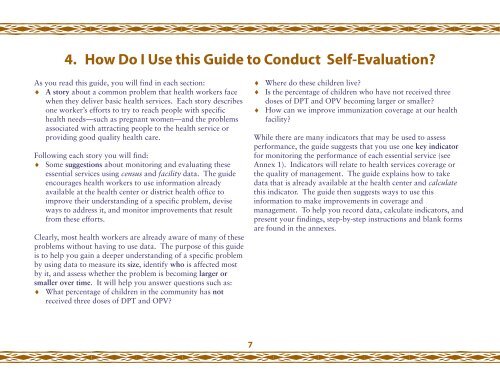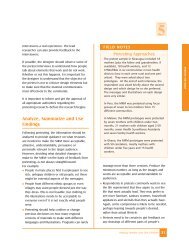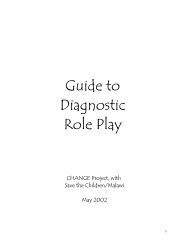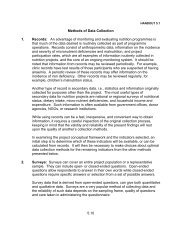Using Data to Improve Service Delivery - A Self-Evaluation Approach
Using Data to Improve Service Delivery - A Self-Evaluation Approach
Using Data to Improve Service Delivery - A Self-Evaluation Approach
Create successful ePaper yourself
Turn your PDF publications into a flip-book with our unique Google optimized e-Paper software.
4. How Do I Use this Guide <strong>to</strong> Conduct <strong>Self</strong>-<strong>Evaluation</strong>?<br />
As you read this guide, you will find in each section:<br />
♦ A s<strong>to</strong>ry about a common problem that health workers face<br />
when they deliver basic health services. Each s<strong>to</strong>ry describes<br />
one worker’s efforts <strong>to</strong> try <strong>to</strong> reach people with specific<br />
health needs—such as pregnant women—and the problems<br />
associated with attracting people <strong>to</strong> the health service or<br />
providing good quality health care.<br />
Following each s<strong>to</strong>ry you will find:<br />
♦ Some suggestions about moni<strong>to</strong>ring and evaluating these<br />
essential services using census and facility data. The guide<br />
encourages health workers <strong>to</strong> use information already<br />
available at the health center or district health office <strong>to</strong><br />
improve their understanding of a specific problem, devise<br />
ways <strong>to</strong> address it, and moni<strong>to</strong>r improvements that result<br />
from these efforts.<br />
Clearly, most health workers are already aware of many of these<br />
problems without having <strong>to</strong> use data. The purpose of this guide<br />
is <strong>to</strong> help you gain a deeper understanding of a specific problem<br />
by using data <strong>to</strong> measure its size, identify who is affected most<br />
by it, and assess whether the problem is becoming larger or<br />
smaller over time. It will help you answer questions such as:<br />
♦ What percentage of children in the community has not<br />
received three doses of DPT and OPV?<br />
♦ Where do these children live?<br />
♦ Is the percentage of children who have not received three<br />
doses of DPT and OPV becoming larger or smaller?<br />
♦ How can we improve immunization coverage at our health<br />
facility?<br />
While there are many indica<strong>to</strong>rs that may be used <strong>to</strong> assess<br />
performance, the guide suggests that you use one key indica<strong>to</strong>r<br />
for moni<strong>to</strong>ring the performance of each essential service (see<br />
Annex 1). Indica<strong>to</strong>rs will relate <strong>to</strong> health services coverage or<br />
the quality of management. The guide explains how <strong>to</strong> take<br />
data that is already available at the health center and calculate<br />
this indica<strong>to</strong>r. The guide then suggests ways <strong>to</strong> use this<br />
information <strong>to</strong> make improvements in coverage and<br />
management. To help you record data, calculate indica<strong>to</strong>rs, and<br />
present your findings, step-by-step instructions and blank forms<br />
are found in the annexes.<br />
7

















